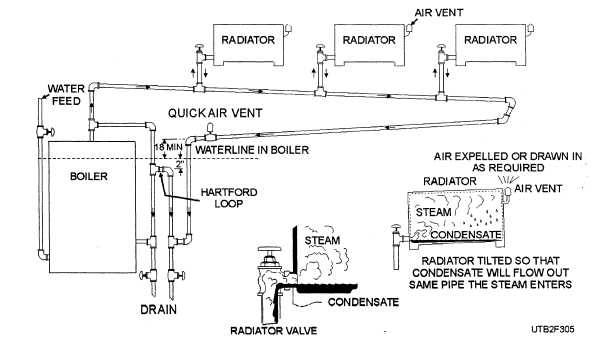distribution systems. The maintenance required on conduit and utilidors consists of keeping the materials of which they are constructed from being damaged and of ensuring that water is kept out of the tunnels and pipes. The maintenance required on outside metal coverings is about the same as that for the conduit and utilidors.
Q1. What are the two classifications of exterior steam distribution systems?
Q2. Conduit and utilidor steam distribution systems are normally installed as a permanent installation because of what reason?
Q3. What is the main disadvantage of an overhead steam distribution system?
INTERIOR STEAM DISTRIBUTION SYSTEMS
Learning Objective: Recognize types and configuration of interior distribution systems. Understand their basic installation, operation, and maintenance.
Interior steam distribution systems may be classified according to pipe arrangement, accessories used, method of returning condensate to the boiler, method of expelling air from the system, or the type of control used. The interior steam systems discussed in this chapter are classified according to pipe arrangment.
Steam may be fed to interior steam distribution systems from a boiler in the same building or from the exterior distribution system of a central plant.
GRAVITY, ONE-PIPE, AIR-VENT SYSTEM
The gravity, one-pipe, air-vent system, as shown in figure 3-5, is one of the oldest types of internal distribution systems. Its capacity is usually ample, and its installation cost is low. Because the condensate is returned to the boiler by gravity, this system is usually confined to one building and is seldom used as a central plant distribution system. The steam is supplied by the boiler and is carried by a single system of piping to the radiators. The return of condensate depends upon the hydrostatic head. Therefore, the end of the steam main, where the main is drained to the wet return, should be high enough above the waterline to provide the required hydrostatic head above the entrance to the boiler. The radiators in the system are equipped with an inlet valve and an air valve. The inlet valve is the radiator shutoff valve, while the air valve permits the venting of air from the radiators. Condensate is drained from the radiators through the same pipe that supplies the steam; they flow in opposite directions, however, which is a dis- advantage. Under certain conditions, the condensate is held in the radiators. This causes noisy operation and a fluctuating water level in the boiler. Water hammer and slow heating are characteristic of this system when the pipe sizing, pitch, and general design are inadequate.

Figure 3-5. - A gravity, one-pipe, air-vent system.
Continue Reading